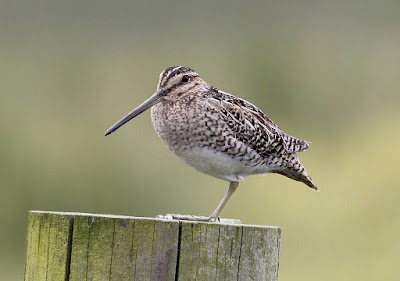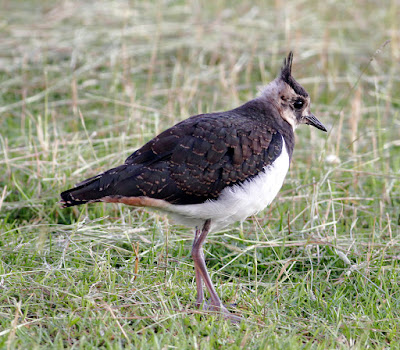There’s local news below but firstly, and after my news about the Herring Gull that likes to shop, comes exciting news about another species of gull – the Little Gull Hydrocoloeus minutus. It's a species which we don't see too often here in Lancashire unless there's a major storm in mid-winter.
Little Gull - Ekaterina Chernetsova from Saint-Petersburg,
[CC BY 2.0], via Wikimedia Commons
Chicks of the world's smallest species of gull have hatched for the first time in Britain at a bird reserve in Aberdeenshire. The hatching of two Little Gulls happened at RSPB Scotland's Loch Strathbeg site near Fraserburgh.
This is the first time the species had been recorded raising young in Britain. A pair nested on a small island which is home to more than 130 pairs of Common Terns.
Richard Humpidge, RSPB Scotland sites manager, said: "We were really excited to discover that the Little Gulls had successfully hatched. It wasn't long ago that the island was home to just 10 pairs of Common Terns that struggled to raise any chicks. Four years, hundreds of hours of help from volunteers and 10 tons of shingle later, there's more than 130 pairs of terns with lots of large tern chicks and now we've got two tiny Little Gull chicks as well - a first for Britain."
As a contrast to the many reports of declining species it’s great to hear some positive news about a bird on the increase.
Today I paid visits to Conder Green and Glasson Dock where I enjoyed a couple of hours of birding before the clouds rolled in. There are always birds to see at Glasson Dock where the unkempt nature of a working port coupled with the separate waters of the port itself and the adjoining yacht basin provide lots of opportunities for birds. Come the early morning quiet of late summer the vessels of all shapes and sizes provide lots of spots for Kingfishers to watch and wait.
It’s a fair stretch across the moorings where a tiny Kingfisher can be invisible against the dock sides or a dark hulled boat but where the single call or a sudden splash of water provides the evidence that a Kingfisher is around. This morning it was a tussle with a passing Swallow which drew my attention to the Kingfisher as it called in protest at a humble Swallow wishing to share the same spot. Having won the argument the Kingfisher sat for a while before flying across to sit along the rails which guard against pedestrians falling into the water after visiting the Victoria Hotel late at night.
I drove slowly to the far side of the dock from where the Kingfisher departed and to where it eventually returned - until it spotted my face and camera lens filling the car window. A Kingfisher is a genuine challenge to any budding photographer, a Swallow less so.
I found a decent selection of birds around the area, including 30+ House Sparrows, 8 Goldfinch, 1 Common Tern, 12 Swift, 4 Collared Dove, 2 Pied Wagtail, 1 Blackcap, 8 Blackbird, 2 Song Thrush, 8 Swallow, 4 Chaffinch, 4 Tufted Duck, 1 Great Crested Grebe and 1 Common Sandpiper. That’s pretty good entertainment for somewhere that many a birder might find uninspiring.
As I drove towards Conder Green a Sparrowhawk performed a flap-glide across the road ahead before disappearing into the caravan site. Sparrowhawks should be more visible in the next few weeks, a typical sort of date when they have young in the nest and when adults spend more time hunting to feed a growing family.
More Swifts were hunting above the Conder hawthorn hedgerow – about 30 or so. It seems to be a favoured morning feeding spot for the Swifts and Swallows and when insects take to the wing.
On the pool and in the creeks; 2 Common Tern + young, 3 Avocet, 7 Common Sandpiper, 3 Pied Wagtail, 1 Little Egret, 1 Grey Heron, 1 Teal, 3 Wigeon, 1 Shelduck and 1 Little Grebe.
There was a single Teal today feeding quietly and apparently harmlessly along the muddy edge of the pool when an Avocet flew noisily at the duck and chased it out into the water. Avocets in a colony are known to be aggressively defensive and chase off any other species of birds that try to nest among or near them. Clearly one of the Conder Green pair also dislikes any bird which feeds along “its” stretch of water. No wonder then that the annoyed remark "Avocet - Exocet" is often heard from some British birdwatchers where Avocets have taken over similar wetland areas.
We’ll have to keep a close eye on those Avocets. We don’t want them taking over Conder Pool to the exclusion of every other species do we?
Linking today to World Bird Wednesday, Anni's Birding and Eileen's Saturday Blog.
Glasson Dock - Lancashire
Glasson Dock - Lancashire
It’s a fair stretch across the moorings where a tiny Kingfisher can be invisible against the dock sides or a dark hulled boat but where the single call or a sudden splash of water provides the evidence that a Kingfisher is around. This morning it was a tussle with a passing Swallow which drew my attention to the Kingfisher as it called in protest at a humble Swallow wishing to share the same spot. Having won the argument the Kingfisher sat for a while before flying across to sit along the rails which guard against pedestrians falling into the water after visiting the Victoria Hotel late at night.
I drove slowly to the far side of the dock from where the Kingfisher departed and to where it eventually returned - until it spotted my face and camera lens filling the car window. A Kingfisher is a genuine challenge to any budding photographer, a Swallow less so.
Kingfisher
Swallow
I found a decent selection of birds around the area, including 30+ House Sparrows, 8 Goldfinch, 1 Common Tern, 12 Swift, 4 Collared Dove, 2 Pied Wagtail, 1 Blackcap, 8 Blackbird, 2 Song Thrush, 8 Swallow, 4 Chaffinch, 4 Tufted Duck, 1 Great Crested Grebe and 1 Common Sandpiper. That’s pretty good entertainment for somewhere that many a birder might find uninspiring.
Goldfinch
As I drove towards Conder Green a Sparrowhawk performed a flap-glide across the road ahead before disappearing into the caravan site. Sparrowhawks should be more visible in the next few weeks, a typical sort of date when they have young in the nest and when adults spend more time hunting to feed a growing family.
Sparrowhawk
More Swifts were hunting above the Conder hawthorn hedgerow – about 30 or so. It seems to be a favoured morning feeding spot for the Swifts and Swallows and when insects take to the wing.
On the pool and in the creeks; 2 Common Tern + young, 3 Avocet, 7 Common Sandpiper, 3 Pied Wagtail, 1 Little Egret, 1 Grey Heron, 1 Teal, 3 Wigeon, 1 Shelduck and 1 Little Grebe.
Common Sandpiper
There was a single Teal today feeding quietly and apparently harmlessly along the muddy edge of the pool when an Avocet flew noisily at the duck and chased it out into the water. Avocets in a colony are known to be aggressively defensive and chase off any other species of birds that try to nest among or near them. Clearly one of the Conder Green pair also dislikes any bird which feeds along “its” stretch of water. No wonder then that the annoyed remark "Avocet - Exocet" is often heard from some British birdwatchers where Avocets have taken over similar wetland areas.
Avocets - The Crossley Guide to Britain & Ireland
We’ll have to keep a close eye on those Avocets. We don’t want them taking over Conder Pool to the exclusion of every other species do we?
Linking today to World Bird Wednesday, Anni's Birding and Eileen's Saturday Blog.

















































































